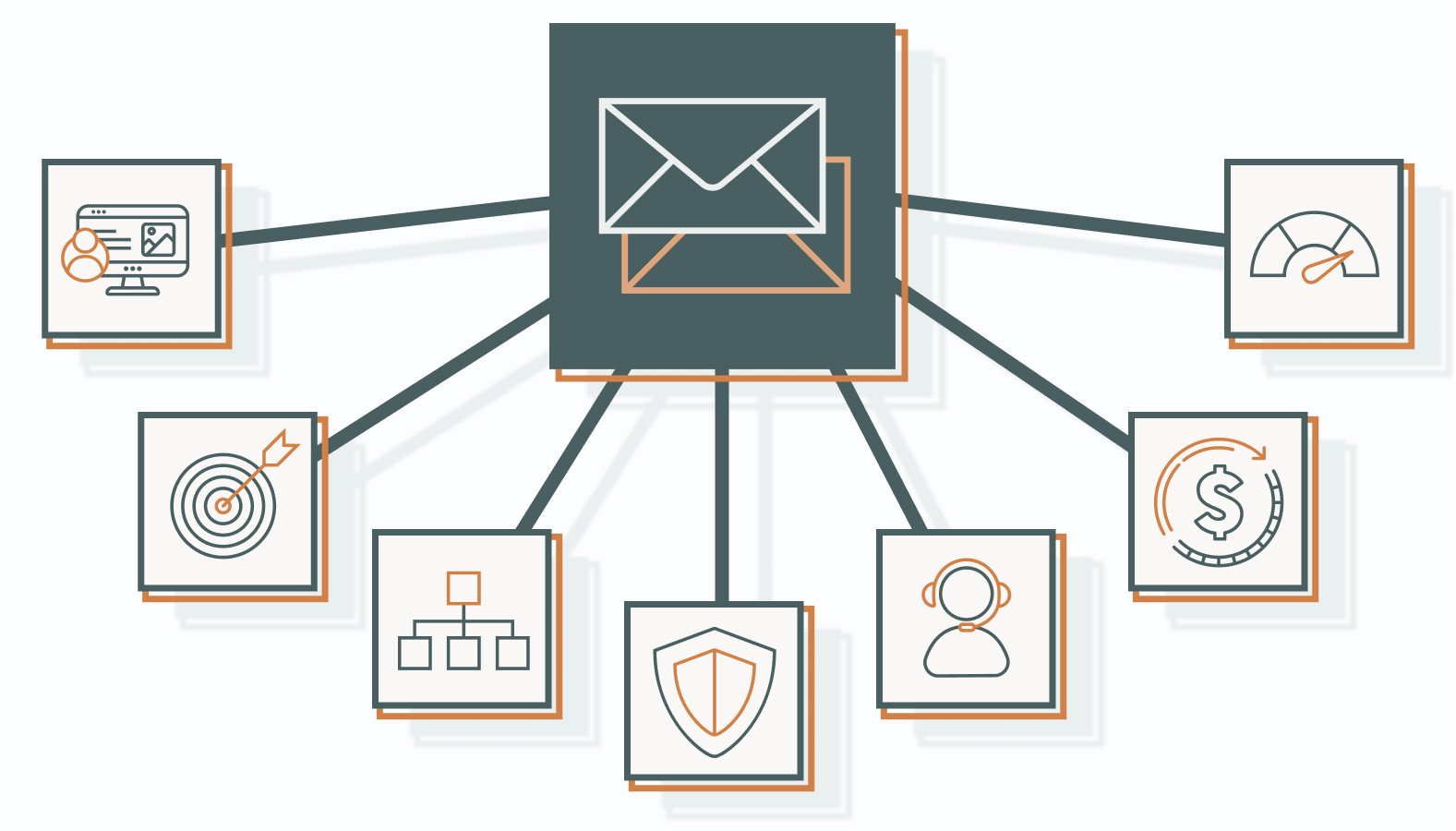In B2B marketing, email platforms have transcended their origins as mere digital megaphones. They have evolved into the engines of intelligent, scalable communication. Today’s tools are not just about sending messages; they are about crafting experiences, segmenting audiences, automating follow-ups, and translating analytics into actionable insights.
What began as digital direct mail has matured into a sophisticated ecosystem capable of predicting behaviors, personalizing content at scale, and integrating seamlessly with CRMs. This evolution results in smarter campaigns, improved conversion rates, and fewer missed opportunities.
Understanding how to select and utilize modern B2B email software provides a competitive edge. Here’s how to get it right.
Tailor Solutions to Your Business Needs
A one-size-fits-all approach won’t drive results.
To thrive in B2B marketing, your tech stack and strategies must align with your specific goals and growth stages.
By identifying these needs, companies can choose strategies and tools that support their objectives and enhance overall marketing performance.
Evaluate Your Marketing Needs
Start by conducting a comprehensive analysis of your current marketing strategies. Identify strengths, weaknesses, and areas for improvement. This process clarifies where your company stands and what changes are necessary for progress.
Understanding your target audience and market trends is equally crucial. This knowledge enables the development of marketing strategies that resonate deeply with customers, ensuring your messages are engaging and impactful, ultimately leading to enhanced results.
Ensure Scalability and Seamless Integration
Scalability should be a priority when choosing marketing solutions.
Tools that can grow with your business are vital, as non-scalable solutions can hinder future growth. It’s important to select flexible platforms that can expand as your needs evolve.
Equally important is the seamless integration of new marketing tools with existing systems. Integration enhances data flow, reduces redundancies, and streamlines operations, ensuring all your tools work harmoniously together.
This cohesive operation increases efficiency and provides a comprehensive view of your marketing efforts, enabling better decision-making and strategy development.
Address Industry-Specific Email Needs
Core B2B email principles apply across the board, but niche industries often require tailored strategies and platform capabilities. For example:
- Technical Fields: Prioritize deep content like specs, white papers, and technical webinars. Look for platforms that support complex segmentation and data formatting.
- Government/Public Sector: Emphasize compliance, security, and long-term value. Content should lean toward thought leadership and policy updates.
- Manufacturing & Industrial: Focus on product specs, maintenance alerts, and visuals like diagrams or case studies for operations and procurement roles.
- SaaS & Tech: Use personalized onboarding, feature updates, and ROI-focused content. Platform integration and automation are key.
Understand your industry’s communication norms, challenges, and compliance needs. A tailored approach outperforms a one-size-fits-all strategy every time.
Leading B2B Email Marketing Platforms
Picking the right email marketing platform can make a big difference in how you connect with leads and grow your business. The right tool helps you engage prospects, nurture relationships, and turn them into loyal customers.
Here’s a look at some of the top platforms available today, each with features built for different business needs.
1) ActiveCampaign: Best for Advanced Automation & Lifecycle Marketing
ActiveCampaign stands out for its advanced automation tools that support deeply personalized customer journeys. These automations help businesses deliver tailored experiences based on customer behavior, boosting engagement and conversions at every stage of the funnel.
Its strength also lies in integrations. ActiveCampaign connects smoothly with countless platforms, giving marketers a centralized hub for managing data and optimizing campaigns.
Ideal For: Mid-sized to large B2B companies that need sophisticated automation and deep customer journey tracking. Especially useful for teams with a strong strategy and technical resources.
Pros:
- Highly advanced automation capabilities
- Robust customer journey tracking
- Extensive third-party integrations for holistic data use
Cons:
- Steeper learning curve for beginners
- Pricing may scale quickly for larger teams
- Interface can feel overwhelming due to feature depth
2) HubSpot: Best for All-in-One Marketing & CRM Integration
HubSpot delivers a powerful all-in-one marketing suite that integrates seamlessly with its CRM, giving teams a unified system for managing both marketing and sales. This integration allows for better alignment across departments, improving lead handoff and campaign targeting.
Its analytics and reporting tools offer detailed insights into campaign performance and customer behavior, making it easier to continuously refine strategies based on real-time data.
Ideal For: Growing B2B organizations looking for a unified platform to connect marketing, sales, and CRM, especially where team collaboration and reporting are priorities.
Pros:
- Unified CRM and marketing platform
- Strong analytics and reporting capabilities
- Scalable for businesses of all sizes
Cons:
- Higher pricing tiers can be costly
- Certain features locked behind expensive plans
- Initial setup can be time-consuming
3) Mailchimp: Best for Easy Design & Quick Campaign Launches
Mailchimp has transitioned from a basic email platform to a full-featured marketing solution fit for B2B operations. Its automation and segmentation features help businesses craft targeted campaigns that speak directly to segmented audiences.
Mailchimp’s intuitive design and drag-and-drop tools make it particularly user-friendly. It simplifies content creation without compromising professionalism.
Ideal For: Small to mid-sized businesses that want a user-friendly platform with decent automation and creative flexibility, especially those newer to email marketing.
Pros:
- Easy-to-use interface and content creation tools
- Solid automation and segmentation features
- Flexible for small to mid-sized businesses
Cons:
- Automation features are limited on lower-tier plans
- Reporting lacks the depth of competitors
- Fewer native integrations compared to enterprise solutions
4) MarketHero: Best for ROI-Focused Email Marketing
MarketHero focuses heavily on tracking sales conversions and return on investment, making it an attractive choice for performance-driven marketers. Its ROI-centric approach ensures that email campaigns are aligned with business growth objectives.
B2B-specific tools like lead scoring and advanced analytics give marketers visibility into lead quality, helping prioritize follow-ups and improve pipeline management.
Ideal For: B2B companies focused on lead conversion and revenue attribution—particularly performance marketers who want detailed ROI tracking.
Pros:
- Emphasis on ROI and sales conversion tracking
- Built-in lead scoring tailored to B2B
- Clean dashboard with actionable insights
Cons:
- Smaller ecosystem and community support
- Less flexibility for complex campaigns
- May not suit businesses that don’t require sales tracking
5) Sendinblue: Best for Budget-Friendly, Multi-Channel Messaging
Sendinblue differentiates itself from a multi-channel communication platform, combining email, SMS, and live chat into a single interface. This approach enhances B2B reach and responsiveness across different customer touchpoints.
Its pricing model especially appeals to small and growing businesses, offering scalable plans that won’t overwhelm the budget.
Ideal For: Budget-conscious businesses and startups seeking multi-channel communication in a single, easy-to-use platform.
Pros:
- Multi-channel capabilities (email, SMS, chat)
- Affordable, scalable pricing
- GDPR-compliant with strong data privacy features
Cons:
- Fewer templates and design options
- Automation tools are less advanced
- Limited integrations compared to premium tools
6) Constant Contact: Best for Beginners & Hands-On Support
Constant Contact offers a reliable platform known for dependable customer support and straightforward campaign management. Its support resources and onboarding tools are ideal for teams looking for guidance as they scale.
With a large variety of templates and customization options, businesses can easily create branded campaigns that maintain consistency across marketing efforts.
Ideal For: Small B2B teams or newcomers to email marketing who want a simple, reliable platform with hands-on support and pre-built templates.
Pros:
- Excellent customer support and onboarding
- Wide variety of email templates
- Intuitive for first-time users
Cons:
- Limited automation features
- Reporting and analytics are fairly basic
- Lacks advanced segmentation for large lists
How to Choose the Right B2B Email Marketing Software
The best B2B email marketing platform isn’t just “top-rated.” It should be tailored to fit your workflows, align with your objectives, and scale as you grow.
The right tool should eliminate bottlenecks, not introduce new ones. When your tech works with your team, not against it, you’ll notice the impact in both execution and outcomes.
Here’s what to prioritize:
Focus on Usability and Interface Design
Don’t underestimate interface design.
A clean, intuitive UI minimizes onboarding friction and boosts adoption across teams. If your marketers need a manual to build a campaign, that’s a problem.
Look for well-designed dashboards, logical navigation, and accessibility features that help users stay productive without extra clicks or confusion.
Customize to Your Business Needs
Your processes shouldn’t bend to the software. The right platform offers customization options that support how you operate.
Whether it’s automated workflows, custom fields, or personalized dashboards, flexibility is key, especially as your business evolves.
Choose tools that grow with you, not ones you’ll outgrow. Figuring this out at the beginning prevents the need for frequent replacements or upgrades, saving both time and resources.
Seamless Integration with Existing Tools
A disconnected stack slows everything down. Prioritize tools that play well with your existing CRM, analytics, and project management software.
When platforms sync in real-time, you eliminate silos, reduce duplicate work, and improve decision-making with unified data.
For bigger companies, these built-in integrations also streamline workflows and enhance data flow across departments.
Prioritize Security and Data Protection
In today’s environment, data protection is table stakes.
Look for software with strong encryption protocols, secure hosting, and a clear roadmap for ongoing updates to protect sensitive information.
Bonus points for compliance with industry-relevant regulations like GDPR, HIPAA, or SOC 2 to reduce the risk of data breaches or legal issues.
Access Comprehensive Support and Learning Resources
When something breaks (or before it does), access to real help matters.
Prioritize platforms with robust support channels, responsive customer support, and a library of up-to-date documentation, tutorials, and community forums.
Good support reduces downtime and improves problem-resolution times. The availability of resources builds team confidence, empowering them to troubleshoot issues independently and quickly.
Evaluate Cost Efficiency and Value
Consider both upfront and long-term costs, including upgrades, integrations, and additional services. Don’t just look at price; evaluate return on investment (ROI) by weighing productivity gains, cost savings, and performance improvements.
Cheap can get expensive fast. A lower-priced tool may lack scalability or incur hidden fees that erode value. On the other hand, a higher-cost solution that improves efficiency, reporting, or conversion rates can deliver significantly better ROI.
Choose a platform that delivers measurable value and contributes to your bottom line over time.
Ensure High Performance and Dependability
Consider the software’s track record for speed and reliability. Consistent performance builds user trust and helps maintain smooth daily operations with minimal disruptions.
Review platform uptime, loading speeds, and service-level agreements (SLAs), which define the expected availability and support standards.
Every outage chips away at productivity and erodes your team’s confidence in the tool.
Strategies for Effective B2B Email Marketing
B2B email marketing demands a different playbook than B2C. With longer sales cycles and multiple decision-makers, the stakes — and the opportunities — are higher.
However, this complexity also unlocks engagement, trust, and long-term value.
To capitalize on these opportunities, businesses need targeted strategies tailored to the priorities of a professional audience.
Segment Your Audience
Segmentation is crucial in B2B email marketing.
By dividing your email list into segments based on industry, company size, role, or engagement level, you can tailor your messaging to meet the specific needs of each group.
For instance, a tailored email for a small tech startup might focus on innovation and scalability, while a large enterprise might appreciate insights into efficiency and integration.
This targeted approach increases engagement rates by ensuring that each recipient receives content relevant to their interests and needs.
Personalize Your Messages
Effective personalization goes far beyond just addressing the recipient by name. Leverage CRM and behavioral data to deliver content based on user activity, past purchases, or job functions.
A tailored insight beats a generic pitch every time. Recommend products based on previous purchases or provide industry-specific insights.
Done right, personalization scales your communication’s impact on the recipient without sacrificing relevance.
Focus on Building Relationships
B2B isn’t exclusively transactional. It must also be relational.
Use email to deliver strategic value: industry insights, useful tools, and actionable content aligned with your audience’s goals.
Consistent, thoughtful communication helps nurture relationships and build trust. Over time, you become more than just their vendor — you become their partner.
Optimize Email Designs for Clarity and Professionalism
A clean, professional email design reflects your brand’s identity and enhances readability.
Ensure your emails are visually appealing and easy to navigate. Keep layouts clean, fonts legible, and navigation intuitive.
Double-check for responsive formatting. Every email must look sharp on any device, whether viewed on a desktop or mobile.
A polished design complements your message, reinforcing your brand’s professionalism and credibility.
Leverage Automation Strategically
Automation is a powerful tool in B2B email marketing. It lets you send timely, relevant emails triggered by specific actions such as website visits or previous purchases.
Setting up drip campaigns (or an automated series of emails based on preset schedules or behavioral triggers) keeps leads engaged and nurtures them through the sales funnel.
Smart workflows ensure your messaging hits the mark without overwhelming your team or audience.
Incorporate Clear Calls-to-Action
Every email should lead somewhere. Craft clear, compelling calls-to-action (CTAs) that guide recipients to the next step, whether visiting a landing page, signing up for a webinar, or downloading a white paper.
Place CTAs prominently within your emails, using contrasting colors and concise language to draw attention. Test different versions of CTAs to help identify which designs and placements yield the highest conversion rates, ensuring your emails drive the desired actions.
How to Launch Your B2B Email Marketing Campaign Successfully
B2B email marketing is a precision tool for driving revenue. Whether you’re reviving dormant accounts or deepening engagement, a well-executed campaign delivers measurable results.
Here’s your executive-level blueprint for launching B2B email campaigns that perform.
1) Set Up and Ensure Compliance
The setup phase determines the integrity and deliverability of your campaign.
Start by configuring the essential account settings properly:
- Sender Information: Use a trusted, humanized sender name (e.g., “[First Name] at [Company]”) to boost open rates and avoid spam filters. This ensures your recipients recognize your communications.
- Domain Authentication: Configure SPF, DKIM, and DMARC records to improve deliverability, protect sender reputation, and validate legitimacy to ISPs.
- Email Preferences: Let subscribers control email frequency and topic preferences. This strategy reduces unsubscribes and improves engagement.
- CRM and Tool Integration: Connect your email platform with your CRM, analytics, and automation stack for real-time data flow.
Then, lock down compliance to protect deliverability and legal integrity.
Compliance with legal regulations is non-negotiable. Laws like GDPR and CAN-SPAM protect your business from legal issues and preserve trust with your audience.
Make sure you set up emails with these strategies in mind:
- Consent-Driven Lists: Never buy lists. Use double opt-ins to verify subscribers.
- Clear Opt-Outs: Include a prominent unsubscribe link in every email.
- Accurate Identity: Display your business name, physical address, and contact info in the footer.
- Legal Reviews: Document consent for audit readiness. Stay current with GDPR, CAN-SPAM, and any region-specific laws.
Staying compliant means staying trusted, so regularly review compliance guidelines to keep your practices up-to-date and safeguard your brand’s reputation.
2) Manage Your Contact Data Effectively
Effective contact data management minimizes bounce rates and improves deliverability. Your list is your campaign’s engine. Treat it like a performance asset.
Import and Clean Data Thoughtfully
Start by importing contacts meticulously. Ensure data accuracy by:
- De-duplicating Records: Remove redundancies before importing.
- Validating Emails: Use email verification tools pre-import to minimize bounces.
- Formatting Fields: Normalize field entries like job title, industry, and region for effective segmentation.
- Scrubbing Regularly: Prune inactive or outdated contacts to maintain list health and deliverability.
Next, you must segment with intent.
Segmentation tailors email to different audience groups without repeating past strategies. This technique powers relevance, which drives results.
Build your e-mail lists around these criteria:
- Firmographics: Industry, company size, revenue
- Behavior: Email engagement, website activity, past purchases
- Lifecycle Stage: MQL, SQL, new lead, repeat customer
- Job Function: Decision-makers vs. influencers vs. technical users
Smart data hygiene and strategic segmentation unlock more precise messaging, better performance, and higher ROI. Treat your list like the asset it is, not an afterthought.
3) Develop and Design Engaging Content
In B2B, content must do two things: reflect authority and inspire action.
Content Best Practices
Excellent B2B content earns attention quickly and rewards it with substance.
- Start with a Strong Hook: Your first sentence should convey relevance or benefit immediately.
- Focus on One Core Message: Craft concise yet informative emails. Keep your message focused and clear. Don’t cram multiple CTAs into one email.
- Use B2B-Specific Insights: Share use cases, ROI stats, or actionable strategies your audience can apply.
- Stick to Reader-Friendly Tone: Your tone should reflect your brand’s personality, balancing authority with approachability.
Design for B2B Expectations
Your design should carry your message, not compete with it.
- Keep Design Clean: Clear fonts, simple layouts, and intuitive navigation enhance readability and user experience.
- Mobile Optimization: Over 40% of B2B emails are opened on mobile. Use responsive layouts and test on multiple devices.
- Hierarchy of Information: Use headings, bullets, and bold text to guide the reader’s eye and fast scanning.
- Accessible Design: Use alt text for images and adequate contrast for readability.
When your content delivers clarity, credibility, and actionable value, it moves the needle where it matters: pipeline, trust, and conversion.
4) Test and Optimize for Best Results
Optimization isn’t optional; it’s how strong campaigns scale and weak ones get fixed.
A/B Test Strategically
Experiment with elements like subject lines, email body, and call-to-action buttons, to identify what resonates best with your audience. Run controlled tests on one variable at a time to isolate impact:
- Subject Line: Length, tone, personalization
- CTA Button: Wording, placement, color
- Content Order: Test which layout drives higher click-throughs
This data-backed process lets you refine campaigns with precision. Validate results with statistically sound sample sizes before scaling to your whole list.
Measure What Matters
Regularly analyze campaign performance using your software’s analytics tools.
Go beyond vanity metrics and focus on KPIs that map to business outcomes:
- Open Rates: B2B email open rates are generally in the 15-25% range.
However, highly targeted and segmented lists can often achieve higher open rates. Factors like compelling subject lines and sender reputation significantly influence this metric.
Remember that recent privacy updates (like Apple’s Mail Privacy Protection) might impact the accuracy of open rate tracking, making it more of a directional indicator.
- Click-Through Rates (CTR): A good B2B email click-through rate typically falls between 2-5% of delivered emails. This metric reflects how engaging your content is and how effectively your calls-to-action resonate with your audience. Clear and compelling CTAs are crucial for driving clicks.
- Conversion Rate: Conversion rates are the most variable as they depend entirely on your campaign goals (e.g., demo requests, white paper downloads, contact form submissions).
However, aiming for a 1-3% conversion rate of delivered emails is a reasonable starting point for many B2B campaigns.
Optimizing landing pages and ensuring a seamless transition from email to the conversion point is essential.
- Unsubscribe & Bounce Rates: A healthy unsubscribe rate is generally below 0.5%. Higher unsubscribe rates can indicate issues with your targeting, content relevance, or email frequency. Regularly monitor this metric to identify and address potential problems.
Use these benchmarks as a baseline for your own analysis. Consistently track your performance over time and identify trends specific to your audience and industry.
Continuous testing and optimization are key to exceeding these general averages.
5) Execute and Monitor Your Campaigns
Strategic impact is earned in the execution. Details define the difference between results and noise.
Final Pre-Send Checklist:
Run a final QA pass on every e-mail before hitting “send.” Confirm the following:
- All links work and point to the correct landing pages
- Dynamic fields (such as first name and company) render correctly
- Confirm alt text is in place for all visuals
- Send test emails across desktop and mobile
Optimize Send Timing
Schedule sends when your audience is most likely to engage. Focus on:
- High-engagement days (typically Tuesday–Thursday for B2B)
- Timing that aligns with your audience’s time zones and activity patterns
Monitor and Adjust in Real Time
Monitor in real-time and adjust on the fly. Agility keeps your message relevant and performance sharp. Here are some best practices:
- Set automated alerts for anomalies, like a sudden drop in opens or clicks
- Pause underperforming campaigns mid-flight if needed
- Flag top performers for repurposing, retargeting, or follow-up campaigns
Campaign success lives in the details. Execute with precision, iterate with intent, and treat every send as an opportunity to nurture and convert leads into revenue.
Smarter Email Starts with Smarter Execution
B2B email isn’t what it used to be, and that’s a good thing.
The shift from batch-and-blast to data-informed, behavior-driven messaging has opened the door to deeper engagement and higher ROI. But success doesn’t happen by accident.
It takes the proper foundation: modern tools, clean data, segmented lists, sharp content, and a strategy that evolves with your audience. Execution, testing, and compliance all matter.
Treat email as a key part of your growth engine, not just another marketing channel. When done right, it’s one of your pipeline’s most efficient, scalable tools.
Let’s Help You Modernize Your B2B Email
Embarking on the journey of B2B email marketing can be as thrilling as it is rewarding.
Choosing a platform, setting it up, and mapping out a full-funnel email strategy that actually fits your business. It’s a lot, and rushing into execution without a plan rarely works.
Whether you’re evaluating platforms, building a smarter email system, or refining what you’ve already got, we can help.
Schedule a candid conversation with one of our experts. Let’s discuss what works, what doesn’t, and how to make email your most valuable B2B asset.










